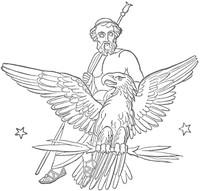Read this ebook for free! No credit card needed, absolutely nothing to pay.
Words: 114603 in 42 pages
This is an ebook sharing website. You can read the uploaded ebooks for free here. No credit cards needed, nothing to pay. If you want to own a digital copy of the ebook, or want to read offline with your favorite ebook-reader, then you can choose to buy and download the ebook.


: Poems Every Child Should Know The What-Every-Child-Should-Know-Library by Burt Mary E Mary Elizabeth Editor - English poetry; American poetry Children's Anthologies
THE FEATHER SYMBOL IN ANCIENT HOPI DESIGNS
J. WALTER FEWKES
Although the prehistoric Indians of Tusayan have left no written records in the forms of books, documents, or codices, there survives from their time a most elaborate paleography which has been preserved on imperishable material in the dry soil of Arizona for several centuries. This paleography is a picture writing, often highly symbolic and complicated, but from it the student can obtain an idea of Hopi thought and its expression at that remote time. It reveals phases of ancient life which have been modified or lost in the subsequent development of the race.
The most abundant of all objects found in the ruins scattered over the Southwest are fragments of pottery, and if the cemeteries of these ancient habitations are excavated large collections of decorated bowls, vases, and jars may be had from any ruin of considerable size. The majority of these fragments of pottery from Tusayan are richly decorated with designs, some of which are very complicated. The figures represented in this ornamentation are often realistic, but many are highly symbolic and conventionalized. It is an object of the present article to discuss one symbol of the latter group, and for this purpose I have chosen the feather, which, through its metamorphosis in form, is one of the more difficult to recognize.
Before passing to a consideration of the feather in ancient Hopi symbolism, it may be interesting to note that very few of the figures with which pottery from pueblo ruins is decorated have been interpreted, and we may say that the study is as yet in its infancy. The ancient Tusayan ware bears several designs of a simple, geometric shape, which are widely distributed over the whole Pueblo area of the Southwest. So far, however, as my knowledge of ancient Pueblo paleography goes, the symbols of the feather as here indicated are confined to ruins of villages which are purely Hopi in origin, although they may later be found elsewhere in Arizona or New Mexico.
I have shown in several previous publications on the ceremonials of the Hopi ritual the significant part which the figure of the feather plays in the decoration of altars and ceremonial paraphernalia, but I am unaware that any one has yet called attention to the very important use of the feather symbols in the decoration of ancient Hopi ceramics. A pottery ornamentation has a religious intent, and, since from its presence as a decorative element there is every reason to believe that the feather in ancient times held much the same position in the ritual as at present, it is instructive to trace its many variations as a symbol.
While what is here written is drawn more especially from the paleography of Sikyatki, it is true, likewise, of that represented in all the Tusayan ruins where yellow ware is abundant. I might instance examples from old Cu?opavi, Kisakobi or Old Walpi, and Old Mico?inovi. It does not, however, hold in all particulars when we study the red ware characteristic of the ruins along the Little Colorado river, where the feather takes another symbolic form not fully discussed in the present article. It applies to representations of the feather as depicted on altars now in use in Tusayan, symbols of feathers on dolls and ceremonial paraphernalia used by people who are lineal descendants of the inhabitants of the ruined pueblos mentioned above. The ruins of Sikyatki lie about three miles east of Walpi, and the pueblo of which they are the remains was destroyed previously to the middle of the sixteenth century.
I have grouped all the striking modifications in bird and feather symbols in close approximation in an installation of the more instructive pieces of pottery from Sikyatki in the National Museum, at Washington, and the reader may there find a larger series illustrating ancient Hopi paleography than has ever before been displayed. A forthcoming report of the Bureau of American Ethnology, under the auspices of which institution these objects were collected, will describe these variations in detail, and as this report is elaborately illustrated, the reader will soon have abundant published material from which to study modifications of the feather symbol in ancient Tusayan.
We have no difficulty in recognizing among the many figures of animals which the ancient Hopi potter depicted on her wares the great group to which any one belongs. Four-legged animals of two kinds, frogs and lizards, are readily separated from mammals; apodal reptiles or snakes are easily distinguished from both, and there is no difficulty in separating the moth or butterfly from the spider or dragon-fly. The great group to which the animal depicted belongs is not difficult to discover, and from a large series of related designs one may trace quite readily the changes in form which have resulted in highly conventionalized modifications.
The ancient Hopi decorator not only represented birds in many more different shapes than she did other animals, but even decorated other animals with feathers in accordance with ancient traditions. Nor did she stop with animals; symbolic figures of the sun or the lightning or the rainbow have symbols of feathers attached to them, and this, to us incongruous, association is often essential to indicate the symbol. This predominance in the number of pictures of feathered gods is a faithful reproduction of denizens of their ancient Pantheon. The majority of the gods were avian in character, even when anthropomorphic. Several animals, as mythic lizards, snakes, and even mammalian forms, are represented in ancient pictography, furnished with crests of feathers on their heads. These are drawn in this way in conformance with ancient legends, and, with traditions to guide us, we have little difficulty in determining some of the symbolic forms which the feather takes in pictography. This method is used by me as corroboratory evidence in determining the prescribed symbols of feathers which have been previously identified by their relative positions on the bodies of birds.
It is plain, I think, that having determined from an avian figure the form of the organs and appendages of the bird in their different modifications, due to conventionalism, we are able to recognize the symbolic forms adopted by ancient artists to represent the feathers of wing, tail, or body. If figures of feathers were so well drawn that we could identify them as such, we would have no difficulty in recognizing a feather when drawn on a fragment of pottery, where no other part of a bird was represented. An accurately drawn feather in such cases would be easily recognized; but the feathers made by the ancient Hopi decorators of pottery were not accurate representations--they were symbolic. The only way we can identify them is by association. Having determined the head, body, legs, tail, and wings of an animal which must be a bird, we examine the separate components which form the tail and conclude what part represents a tail feather. We use, in other words, the morphological method of determining the homologies of organs and appendages which we borrow from naturalists and apply to pictographs.
Having thus determined the symbol of a tail or wing feather from their positions in representations of birds and fixing in the mind its form, we are able to recognize it where it reappears, isolated, or in new combinations. While this way of determining the feather symbol was the method adopted, there was brought to its aid likewise the testimony of living priests, among whom knowledge of some of the ancient symbols still survives. This latter aid to a comprehension of the symbols of ancient paleography is valuable, so far as it goes, but it does not take one long to discover that it is limited in its application. Many ancient designs are incomprehensible to living Hopi priests, and their interpretations are in some cases simply conjectural. The decay in knowledge of the meanings of old symbols is due to the fact that most of the ancient symbolism has been replaced by the modern.
Free books android app tbrJar TBR JAR Read Free books online gutenberg
More posts by @FreeBooks

: Autobiography of Friedrich Froebel $c translated and annotated by Emilie Michaelis ... and H. Keatley Moore. by Fr Bel Friedrich Michaelis Emilie Translator Moore Henry Keatley Translator - Fröbel Friedrich 1782-1852



: The Philippine Islands 1493-1898 — Volume 23 of 55 1629-30 Explorations by early navigators descriptions of the islands and their peoples their history and records of the Catholic missions as related in contemporaneous books and manuscripts showing the





